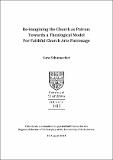Files in this item
Re-imagining the Church as patron : towards a theological model for faithful church arts patronage
Item metadata
| dc.contributor.advisor | Brown, David | |
| dc.contributor.author | Schumacher, Sara | |
| dc.coverage.spatial | 204 | en_US |
| dc.date.accessioned | 2015-03-24T15:47:52Z | |
| dc.date.available | 2015-03-24T15:47:52Z | |
| dc.date.issued | 2015-06-23 | |
| dc.identifier.uri | https://hdl.handle.net/10023/6304 | |
| dc.description.abstract | To date, little academic research has been done on the theological influences undergirding the resurgence of contemporary church arts patronage practice, particularly within Scotland. This project is concerned to uncover not only how theological rationales of the arts inform church patronage but also how churches acting as patrons theologically articulate the reasons for their activity. Can theological rationales for the arts be discerned in contemporary church arts patronage practice? If so, what is their influence? If not, what is influencing church practice? After a brief history of Western church arts patronage and definition of terms, Chapter One discusses the practical theology methodologies used, specifically the Critical Faithfulness model and the Four Voices method. Chapter Two analyses how theological rationales for the arts support and limit church patronage practice with focus on the Catholic, Evangelical Protestant and Reformed traditions. In the first of two case study chapters, Chapter Three explores the patronage practice of Langside Parish Church, Glasgow, a Reformed Church of Scotland, and St Paul’s and St George’s, Edinburgh, an Evangelical Protestant church. Chapter Four considers the patronage of St Andrews Roman Catholic Cathedral, Glasgow and Old Saint Paul’s Episcopal Church, Edinburgh, a church within the Anglo-Catholic tradition. Chapter Five draws from the practice and theology to propose a theological model for best patronage practice, allowing for different definitions of ‘faithful’ church practice as defined by theological tradition. ‘Best practice’ leads to the flourishing of patron, artist, and congregation. After presenting the model, the discussion narrows to consider the nature of the relationship between artist and patron as found in theology and practice. It is argued that key to flourishing in church arts patronage is a dialogical, collaborative relationship between an artistically-inclined patron and a spiritually-sensitive artist with each participating from their strengths while aware of their weaknesses. | en_US |
| dc.language.iso | en | en_US |
| dc.publisher | University of St Andrews | |
| dc.rights | Creative Commons Attribution-NonCommercial-NoDerivatives 4.0 International | |
| dc.rights.uri | http://creativecommons.org/licenses/by-nc-nd/4.0/ | |
| dc.subject | Theology and the arts | en_US |
| dc.subject | Church arts patronage | en_US |
| dc.subject.lcc | BR115.A8S35 | en_US |
| dc.subject.lcsh | Christianity and the arts | en_US |
| dc.subject.lcsh | Art patronage | en_US |
| dc.subject.lcsh | Art and religion | en_US |
| dc.title | Re-imagining the Church as patron : towards a theological model for faithful church arts patronage | en_US |
| dc.type | Thesis | en_US |
| dc.contributor.sponsor | Economic and Social Research Council (ESRC) | en_US |
| dc.type.qualificationlevel | Doctoral | en_US |
| dc.type.qualificationname | PhD Doctor of Philosophy | en_US |
| dc.publisher.institution | The University of St Andrews | en_US |
This item appears in the following Collection(s)
Except where otherwise noted within the work, this item's licence for re-use is described as Creative Commons Attribution-NonCommercial-NoDerivatives 4.0 International
Items in the St Andrews Research Repository are protected by copyright, with all rights reserved, unless otherwise indicated.


